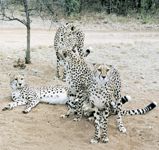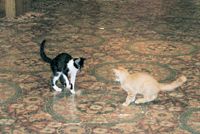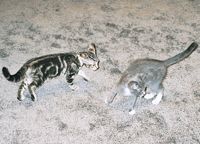Cat signaling: Learn the behavior dance to help patients
We must remember that interactions are a dance with roles for both partners, who each give and request information.
This is the first in a series that deals with cat signaling behavior. If we are to leave the realm of anthropocentric opinion and begin to really understand feline behavior so that we can better intervene when something goes wrong, we need to understand signaling behaviors in a way that attempts to address how the cat sees and uses them.
It's important to realize that no one set of signaling behaviors occur in a vacuum. Visual signals may also be accompanied by tactile signals. Both of these signal types might be accompanied by vocal signals — a reality of feline signaling that has been painfully under-emphasized. All of these signal types, bidden or unbidden, may be accompanied by olfactory signals, a signaling realm that is largely closed to us humans. This means we are almost always going to be missing something about feline signaling, so we should always acknowledge that we could be plagued to an incomplete understanding and because of this, we must work extra hard to take care in reading the signals that are accessible to us.

Karen Overall, DVM
One of the clues about cat signaling lies in name originally given to cats by Herodotus in ancient Greece: Ailurioi, which means tail waivers. Tail signals are one of the most important signal groups for cats.
When considering the importance of tails in feline signaling, it's helpful to remember that the ancestral cat was likely the northern African wild cat, a cat that looks a lot like a very large tabby in present day. These cats evolved in desert environments that included sand, scrub vegetation, reeds and Savannah-like grasslands.

Photo 1
In this environment, striped tails, like those of modern-day cheetahs in South Africa (Photos 1 and 2) provide excellent "disruptive coloration".
Disruptive coloration makes it more difficult to detect an animal's presence and/or movement against certain backgrounds. That said, it logically follows that when cats are willing to be seen, they will elevate and move their tails. So, tail up becomes a signal that cats are willing to be seen, and such cats should then be willing to interact.

Photo 2: Disruptive coloration makes it more difficult to detect an animal's presence or movement. Cheetahs also provide ancestral behavior clues. For example, tail movement is a signal that the animal is willing to be seen.
In fact, this is exactly what research from Sharon Crowell-Davis' lab at the University of Georgia found: Cats, especially those that are preferred associates — cats that wish to spend time with each other — raise their tails as part of their greeting and signal that they are ready to interact.
We can see this type of signal about impending interaction in many inter-cat situations. In Photo 3, we see this quintessentially curious kitten in a hospital environment. Notice that all of the other body signals — the head posture, the ears, the placement of the paws and the overall stance are in agreement. Note the tail posture is up and slightly curved over the rump. Everything about this cat says he is alert and ready to go. His entire body posture is forward, leaning into the potential interaction. His head is up on his back is straight and fully stretched out, suggesting that there is no inclination to withdraw from any part of the interaction. He is simply not hesitating.

Photos 5
His ears are up and forward and so are his eyes, and they are both focused on the same external point. This is a kitten collecting information about the object of his desire. The tail signals that he desires to interact. Notice that all of these signals are concordant.
Get the message across
Concordance is an underused aspect of understanding signaling. There are two main patterns in virtually all types of signaling that will help us understand it.
First, truly important signals are redundant. The more essential a signal is, the more likely it is to be repeated and the more often it is repeated. Think about the last time you were on an airplane. No matter what reading material you explored or what you listened to, there were two main messages that the crew needed to send: use of seat-belts and emergency exit locations. The message is delivered repeatedly and methodically throughout a trip. None of the stuff in the middle matters; it is simply a way to dress up the message of greatest importance. The information is repeated in a variety of ways and in various contexts that it would allow the majority of humans present to get the message.

Photo 6: These cats are showing a willingness to interact but remain uncertain. An arched back as depicted in the top photograph indicates a willingness to flee. The raised forepaw indicates a change in behavior is about to take place.
Get the message across
The information encoded in mammalian DNA is even more redundant. Neurotransmitters are so critical to functioning that there are multiple opportunities to encode for them, and the regions that encode them are diverse and broadly distributed.
The second pattern in signaling is concordance. For example, within a signaling class, all signals given by all body parts and regions are concordant — they all go in the same direction. For visual and postural signals, this means that when the animal is committed to the interaction or situation, the tail agrees with the back, agrees with the ears, agrees with the eyes. When there is some uncertainty or lack of full commitment, some of the signals are not concordant. The back may suggest a link to mobility and movement, while the tail suggests a willingness to be seen. Yet, you can be willing to be seen and willing to flee at the same time. In fact, this is a completely logical signal if you do not wish to be pursued. Signals can also be concordant or discordant across modalities: Your body can say one thing while your voice or your scent says another. Humans do this all the time when they lie.
Clear signaling
So, our kitten in Photo 3 is making sure that he is clearly signaling his wish to interact. Interaction is not necessarily benign, so clear signaling is critical. When this cat is allowed out of his cage (Photo 4), the more the human coaxes him to approach, the less certain he becomes. His topline or back is still parallel to the horizon, his tail is still up, and his front legs are still stretched, but now his ears are up but pulled back a bit, and his gaze is off to the side. He is considering his options, and considering not going to where he is called. The cue that he is uncertain is found in the ears: When the ears are up but partially back, the cat is somewhat indecisive, but definitely not committed to moving immediately forward. Note, also, that from the human's point of view, the cat's neck is turned away. This indicates that the cat is not a threat, and that he is disengaging from the interaction with her, specifically.
We see a variant of this response in the kittens in Photo 5. Note that the striped kitten on the left has his tail curved up, but it is a bit lower. The tail on the grey cat is in a similar position but raised a bit more and is a bit straighter. These kittens are participating in a kitten class and don't know each other.
They are curious and are signaling a conditional willingness to interact, along with their uncertainty. The gray kitten is fully committed to his decision, and his ears are up and forward. He is also moving a bit away from the tabby, and having fully turned his neck and back, clearly feels no serious threat. The tabby's ears are like those of the kitten in Photo 4 — up but back a bit and he is looking at the gray cat. He wants to approach, but he is uncertain.
We must remember that interactions are a dance with roles for both partners, who each give and request information. This is why we see pauses in so many interactions. Pauses give time to observe and process information, and then respond appropriately to it. Such interactions, driven by rules specifying clear and predictable communications, are important aspects of normal signaling behavior in all social species. Cats are no exception.
The importance of integrating various visual signals is depicted particularly well in Photo 6. Again, we have two kittens approaching each other in a kitten class. They are unknown to each other. The black and white cat has a tail up, ears forward and eyes focused on the orange tabby. These are all signs that he is willing to approach and interact. But his weight is all on his left forepaw and his back is arched: signs of both uncertainty and formulating a contingency plan. The arched back indicates a willingness to flee. The raised forepaw indicates that a change in behavior will follow (you'll see this in dogs, too), but that the cat will swat if the interaction doesn't proceed at a different pace and if this option to move away is removed.
Note that the yellow tabby has a curved, elevated tail as seen in most of the earlier illustrations, but he is sitting back and down into it. His ears are up and forward, and he is watching the black and white kitten. The tabby, too, is willing to interact, but is slowing down the pace of the interaction by engaging in partial and then full (off-camera) sitting. It helps to know that sitting is a "stop" signal in dogs and cats.
In the next article in this continuing series, we will look at some of the complexities of tail signaling, and then focus on other body parts and postures. I hope that these pieces serve to help us better understand and appreciate our feline companions and patients so that we can pass on the excitement of understanding signaling to our clients. Clients who watch their animals and allow their animals to teach them their feline or canine signaling language have better relationships with their dogs and cats, and are less likely to relinquish them. This is absolute justification for all veterinarians to make understanding behavior one of their priorities.
Dr. Overall has given hundreds of national and international presentations and short courses and is the author of more than 100 publications on behavioral medicine and lizard behavioral ecology. She is a diplomate of the American College of Veterinary Behavior (ACVB) and is certified by the Animal Behavior Society (ABS) as an Applied Animal Behaviorist.
Veterinary scene down under: IV fluid shortage updates, and more news
September 3rd 2024Updates on the intravenous fluid shortage impacting Australian veterinary practices, a welcome funding boost for the Veterinary and Community Care charity, and Australia’s first Fear Free Certified veterinary practice.
Read More